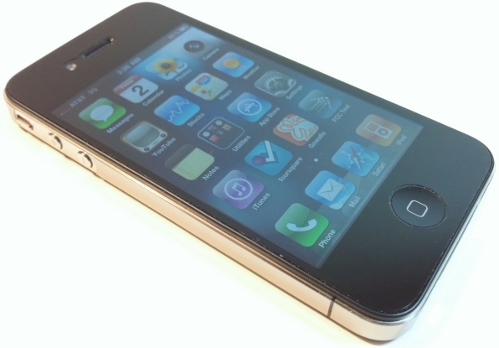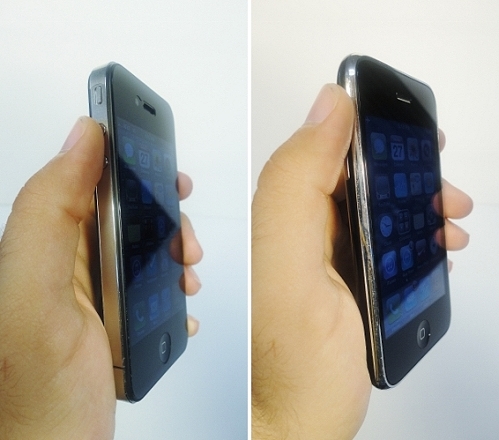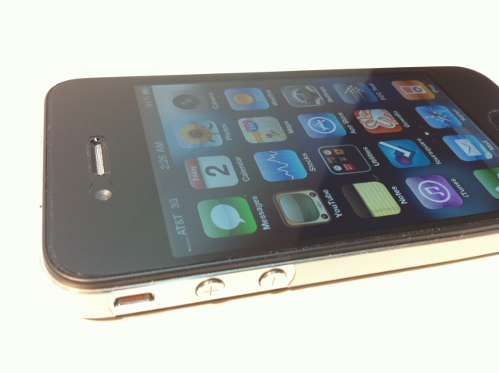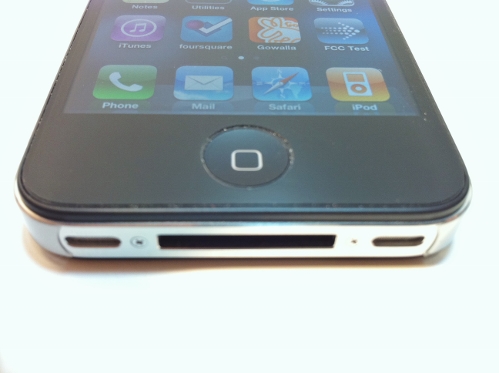Index
Physical Dimensions, Aesthetic Changes
The iPhone 4 is also 25 percent thinner than the iPhone 3GS, measuring in at a mere 0.37 inches thick. In fact, during his WWDC 2010 keynote, Steve Jobs claimed it is currently “the thinnest smartphone on the planet. Based on what the mobile industry has revealed thus far in Q2 2010, we can verify that this statement does in fact hold true. The device no longer features the same “fat” feeling from a curved backside on the iPhone 3GS in 2009 and the iPhone 3G in 2008. For comparison’s sake, the HTC EVO 4G measures 0.47 inches thick, while the iPhone 3GS and iPhone 3G both measure 0.48 inches thick respectively.


Apple was able to redesign the frame of the device to keep it at a very slim 9.3mm thickness. The front and the back of the iPhone 4 are both made out of two pieces of smooth, strengthened glass. Thanks to its recent teardown, iFixIt believes the material is
when a new iPhone is launched.
After the launch event on the morning of June 24th, were fortunate enough to have an appointment set up with the guys at Fusion of Ideas in Irvine, California to have an iPhone 4 StealthArmor shield professionally installed on our device. Serving as better device protection solution than the highly popularized InvisibleShield by Zagg, the company's StealthArmor is fabricated out of industrial grade material originally developed to protect racecar exteriors from flying asphalt while driving at high speeds. The clear shield is designed with nano-fusion technology that offers completely transparent optics - a must have for the iPhone 4 Retina Display - and is guaranteed to protect any mobile device from scratches. Interestingly enough, the full body shield also comes with custom corner and bezel protection strips that serve as an insulation layer between the iPhone 4's external antenna and the user's palm. When AnandTech did an extensive review of the iPhone 4 antenna degradation issues last week, the authors mentioned that Apple should have applied an insulative coating atop the stainless steel bezel, or perhaps even diamond vapor deposition. But now that the marketplace is fully aware of Apple's imprecise engineering imperfections (more on that in Part 2 of this review), mobile device customization and protection companies like Fusion of Ideas have responded to consumer demand with remedies that could perhaps be capable of holding a steady cellular signal while placing a call. But we will address whether or not this theory holds true in a later story.


As far as weight is concerned, all iPhones to date measure in at relatively the same weight, but the density and compactness of the new iPhone 4 hardware can have a subjective variance to it that differs between users. The iPhone 4 and iPhone 3GS both weigh in at 4.8 ounces (135 grams), while the iPhone 3G weighs in at 4.7 ounces (133 grams). In comparison, the HTC Incredible weighs 4.6 ounces (130 grams), the new Motorola Droid X comes in at 5.47 ounces (155 grams), and the HTC EVO 4G comes in at 6 ounces (170 grams). To us, the iPhone 4 feels like it packs more hardware into a smaller surface area and has a noticeably denser feeling than the iPhone 3GS. This is probably due to the removal of the backside curvature being replaced by a rectangular design aesthetic that reminds us of a Gameboy Advance SP when held in the palms.

Coming Up
In the second half of our review, we will address the iPhone 4's antenna design and the controversial reception issue, Apple's new camera sensors, the dynamically clocked A4 processor, memory and internal architecture changes, iOS 4 and overall market acceptance rates so far since launch day.



